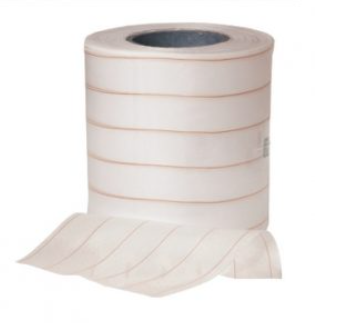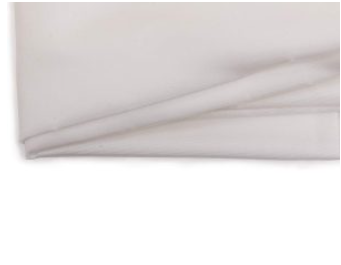879-2 & 879-10 Release Fabric
879-2 and 879-10 are the same tough, finely woven nylon fabric (often called peel ply).

It is used to separate the breather and vacuum bag from the laminate in vacuum bagging operations. Excess epoxy bleeds through and is peeled from the cured laminate along with the Release Fabric. It’s also used in hand lay-up applications to allow more squeegee pressure and protect the lay-up from contamination. Peels easily and leaves a smooth textured surface, ready for bonding or finishing. Can handle post-cure temperatures up to 410°F (210°C). Red tracer indicates peel ply left behind on the laminate.
879-2 Release Fabric, 60″ wide x 2 yd roll
879-10 Release Fabric, 60″ wide x 10 yd roll
879-18 is a tough, finely woven nylon fabric treated with a release agent.

It is used to separate the absorber, breather, and vacuum bag from the laminate in vacuum bagging operations. Excess epoxy bleeds through and is peeled from the cured laminate along with this fabric, which may also be referred to as peel ply. It’s also used in hand lay-up applications to allow more squeegee pressure and protect the lay-up from contamination. Peels easily and leaves a smooth textured surface, ready for bonding, sanding or finishing. Not recommended for post-cure temperatures over 120°F (49°C)
879-18 Release Fabric, 60″ wide x 9″ sheet
The Many Roles of Release Fabric
Crucial in Vacuum Bagging
In a vacuum bagging operation, release fabric should be laid directly on top of the wet laminate. It will leave a textured finish when it is removed, reducing the need for surface prep before secondary bonding. Learn more about vacuum bagging by reading Rachael Geerts’s article Vacuum Bagging Basics in Epoxyworks 49.
Saves Time and Effort in Coating
Release Fabric offers several advantages in epoxy coating applications. Just one layer over a wetted fiberglass laminate is easily smoothed with a plastic squeegee and removes irregularities and trapped air from the surface. The excess epoxy will seep through this fabric’s weave leaving the laminate with a higher fiber-to-resin weight ratio. The result is a strong, lightweight laminate.
Protects Curing Epoxy
This specially treated fabric protects the wet fiberglass cloth as it cures and allows you to level layers of fiberglass without damaging the fabric. It’s left in place until the epoxy cures and can also be left on the surface for an extended period, such as when you want the laminate protected while you complete other work on the project.
Eases Surface Prep
Any time after the epoxy is cured you can easily pull the Release Fabric away. The fabric leaves a weave texture on the fully cured epoxy, which makes it ready to accept a mechanical bond without sanding. In addition, amine blush cannot form under this fabric. Any blush will actually be on top of the fabric, occurring on the epoxy that seeped through to the top of the fabric and was exposed to moisture in the air during cure. Because of this, any blush is peeled away and discarded with the used peel ply.
Helps Smooth Fillets
Our 403 Microfibers and 405 Filleting Blend are excellent structural fillers but they’re fibrous and leave a rough surface when used to make fillets. To end up with a surface that is ready for coating or re-bonding without having to remove amine blush or sand smooth, apply a narrow strip of peel ply after the fillet is made.
For best results, apply the fillet and clean excess epoxy away from its edges. Lay the strip of release fabric over the fillet and with the same application tool that was used to apply the fillet, use gentle pressure to work the fabric into the epoxy. Leave a tab of this fabric as a hand-hold for easy removal.
After the epoxy has cured peel away the release fabric. There is no amine blush to wash away and the textured surface left by the peel ply will allow immediate re-coating.
This procedure can be used for other applications such as smoothing out composite chines and keels in stitch and glue construction and applying over fiberglass cloth in areas where secondary bonding is planned.—Excerpted from Use Release Fabric for Smooth Fillets by Jim Derck in Epoxyworks 4.
